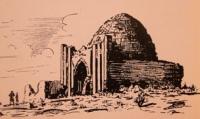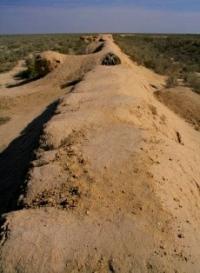Вы здесь
Antique monuments of Lower Syrdarya.


Tours in Kazakhstan.
"History is a witness to the past, light of truth, living memory, teacher of life, herald of antiquity"
Mark Tullius Cicero.
Ancient monuments along Syrdarya river.
The lower reaches of the Syr Darya are the richest territory with archaeological monuments. The natural features of the Eastern Aral Sea region contributed to the development of early agriculture here, starting from the Bronze Age.
At the same time, this territory is of particular interest as a zone of direct contacts of traditional farmers and pastoralists with the relationship between the nomadic and sedentary peoples of the Central Asian-Kazakhstan region.
Here the processes of cultural genesis in ancient times proceeded in such natural and ecological conditions that contributed to the development of both agriculture and cattle breeding. The region was an intermediate, buffer territory between the southern agricultural oases of the early urban civilization and the world of mobile nomadic pastoralists of Eurasia.
A brilliant manifestation of these connections can be traced on the archaeological sites of the Eneolithic Bronze, in particular on the materials of the mausoleum of the Northern Tagisken (Kyzylorda region, Kazakhstan), which was noted by predecessors.
Elements of cultural influence can be traced in a rectangular layout that is not typical for pastoralists, buildings using rectangular bricks, in the facts of involvement in the cult of fire. In the course of those held in 1960 - 1963. field research in the construction technique of the Tagisken mausoleums discovered a building material unconventional for the Bronze Age steppe cultures - brick.
At the same time, the very layout of the mausoleum undoubtedly reflects the local, deep-rooted traditions of constructing monumental buildings in the form of a circle. Thus, in the internal structure of the mausoleums, wooden elements were widely used here - pillars and poles coated with clay, i.e. those elements that are well known from the materials of Andronovo-type settlements and burial grounds.
These facts show that the mausoleums of the Northern Tagisken contain planning structures that combine the traditions of the Andronovo circle cultures and components that are undoubtedly associated with the southern influence of the agricultural culture, which M.A. Itina considers it to be ancient Bactrian.
The archaeological materials available now allow us to distinguish three stages in the development of early urbanization in the lower reaches of the Syrdarya.
The first period - pre-urban: X- end of V century. BC, studied mainly from the burial sites of the Northern and Southern Tagisken and Uygarak.
The second period - initial urbanization: IV - I centuries. BC, when the first urban-type settlements appear (Chirik-Rabat culture).
The third period is developed urbanization: I - VI centuries. AD - the formation of urban culture, urban type, the emergence of settlements.
At the first stage, in the lower reaches of the Syr Darya, groups of the population firmly settled on the land appeared, for which agriculture based on irrigation became a priority occupation combined with cattle breeding.
Urbanization developed further in the second half of the Ist millennium BC, when traditions developed by the agricultural cultures of the south of Central Asia appeared on the territory of the Aral Sea region. At this time, in the Pri-Sarakamysh delta, the ancient Khorezm culture and the oldest fortress Kuzeli-gyr (Khorezm region, Uzbekistan) associated with it were formed.
Excavations have shown that the fortress has gone through two construction periods. For the early period of the construction of the Kuzeli-gyr fortress, the use of rectangular bricks with an aspect ratio of 1: 2 (50 x 25 x 10 cm) is characteristic, which are not characteristic of the subsequent classical antique period of Khorezm, where square bricks of large sizes (40 x 40 x 10 cm ).
The lower layer was dated to the 6th - beginning of the 5th century. BC, and the upper building horizon of Kyuzeli-gyr refers to the end of the 5th century BC. On the territory of the ancient delta of the Syr Darya, in the Kyzylorda region of Kazakhstan, at this time, the Chirik-rabat culture was formed, in which continuity is manifested not only in material culture, but also in funeral rites and rituals with the culture of the population of the Late Bronze period of the lower reaches of the Syr Darya.
Part of the Chirikrabat culture is characterized by the concentration of long-term settlements in groups. Among them are the fortified character. There are two early city centers, Chirik-rabat and Babish-mulla. The first is considered a refuge and residence of the leaders, the second has a regular square layout, a defensive wall with a powerful gateway donjon, with a complex planned, inside so called the Big House, which was, presumably, the residence of the Achaemenid satrap of the IVth century. BC.
Excavations of the Saka burial grounds and settlements of the Chirikrabat culture in the last century were intensively conducted by the detachments of the Khorezm archaeological and ethnographic expedition. Nowadays, since 2004, excavations have been continued by the Chirik-rabat archaeological expedition under the leadership of Zh.Kurmankulov (Institute of Archeology named after A.Kh. Margulan of the Republic of Kazakhstan), several monuments were found (Inkar-kala, Karabas, Sengir-kala 2, etc.), associated with the Chiriqrabat culture.
Conclusion. Summing up a brief overview of the monuments of the 1st millennium BC on the monuments of the Eastern Aral Sea region, we can summarize the following: the formation of urban culture took place under the influence of the Central Asian states, and the role of a relay was played by the sedentary agricultural civilization of ancient Khorezm and Bactria, which arose on the verge of the 7th-6th centuries. BC.
Among the settlements, Babish-mulla settlement stands out. Urban features, which are expressed both in the correct square layout of the fortified settlement outlined by a defensive wall with a powerful perverse donjon, and in an internal complex structure, the so-called Big House.
It can be assumed that this was the administrative center of a significant territory of the Eastern Aral Sea region. Fortified estates such as Balanda, Inkar-kala, Sengir-kala could serve as a community storehouse and, if necessary, a fortress of refuge. It should be noted that such a structure of the fortification finds direct parallels in early antique Khorezm, where small unfortified estates were grouped, as a rule, around a fortress, which served both as a public storage facility and a refuge in case of danger.
The structures of Chirik 3, Karabas, located on the right bank of the Zhanadarya, suggest that they served as fortresses-barracks for the garrison. It is interesting that they were located near the large settlement of Chirik-rabat, which was one of the centers of the oasis.
The Alyb and Kabyl fortresses, as border fortresses, most likely guarded the large settlements of Chirik-rabat, Babish-mulla and the entire northern periphery of the Chirik-Rabat and Babishmulli oases. The Chirik-Rabat settlement with the Saki burial ground stands apart.
We are interested in the question of comparing the Saka burial ground Chirik-Rabat with the herros of the time of Herodotus. In written sources there is an indication of the location of the early Scythian (Saka) necropolises in a remote, inaccessible, hidden from prying eyes area.
It can be assumed that in some respects the Chirik-rabat settlement looks like a sacred, sacred burial place. Thus, according to the ancient Iranian tradition, recorded by M. Boyes, the sacred place where religious rituals were performed (later called by the Zoroastrians "pawi", that is, "clean place"), was arranged quite simply, which corresponded to the life of a semi-nomadic people. It was a flat piece of land, for the Iranians - a rectangle, which was marked with furrows drawn with prayer (in order to avoid the effects of any evil forces).
To mark the sacred site, the delineated area was sprayed with clean water and again consecrated with prayers. The priest sat cross-legged in front of the fire, which was placed in a small vessel, on the ground. Obviously, these actions and “protective fences of earth and stones around her burials (mounds) were typical” in other territories of the Scythian-Saka world.
All these features are characteristic of the modern Zoroastrian ritual, and there are parallels to them in the everyday life of Brahmanism.
Authority:
J. Kurmankulov, J.R. Utubaev. “Ancient monuments of the Lower Syr Darya. http://edu.e-history.kz/ru/publications/view/268







